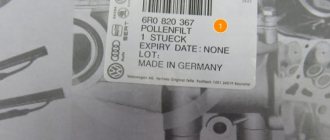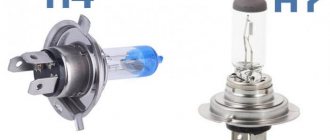The engine is the most important component of a car and requires constant monitoring and care, and one of the main maintenance items is replacing old motor lubricant with new one. Thanks to it, all parts of the power unit are covered with a protective film, which protects them from wear and corrosion. In addition, the lubricant reduces the operating temperature and cleans the inside of the engine from emerging dirt and all kinds of impurities. Using various additives, manufacturers change not only the viscosity of motor oil, but also its various characteristics. In this article we will try to figure out what kind of oil should be poured into the Polo sedan engine and why.
What kind of oil is poured into VW directly at the factory and what kind can be purchased for topping up
High-quality motor oil will make the operation of your car’s engine not only stable, but also more durable, so you should take its purchase very seriously. Today, the market for fuels and lubricants has become so diverse that it is sometimes quite difficult to make a choice. However, if it is necessary to change the oil of a Polo sedan, then you should take into account the recommendations of the manufacturer of this car brand.
German manufacturers have developed four types of oils with the required characteristics for the VW Polo Sedan. These include the following types:
- VW501 01;
- VW502 00;
- VW503 00;
- VW504 00.
These designations correspond to the classification of motor oils according to the ACEAA2 or A3 standard. It should be clarified that the ACEAA classification includes motor oils designed for gasoline engines. Oil class A2 is represented by lubricants that have normal performance properties, as well as standard replacement intervals. Class A3 is represented by liquids that have high performance characteristics that can be used for a longer period of time without replacement. Most often they are used as an all-season lubricant with low viscosity. To minimize possible risks, Volkswagen recommends using only original fluid in its cars. If it is not possible to purchase such oil, you can use any other oil that meets the specifications and tolerances for topping up.
Volkswagen Polo sedan engine, technical characteristics of Volkswagen Polo engines
The Volkswagen Polo sedan engine, which we will talk about today, will be produced directly in Russia in 2015, at the new Volkswagen engine plant. True, the timing chain will be replaced with a belt, and the power of the unit will increase by 5 horsepower. Except for the Polo sedan, a petrol engine with a displacement of 1.
6 liters are now installed on the larger Jetta, Skoda Octavia and Rapid models. The 1.6-liter power unit, the most popular among our customers, is produced in two versions with a capacity of 85 and 105 hp. with 16 valves (factory designation CFNB and CFNA, respectively).
The difference between the 85 horsepower version and the 105 horsepower modification of the Volkswagen Polo engine lies in the design features of the cylinder head and the presence (or absence) of a variable valve timing system.
Naturally, due to the presence of a timing system, the 105 strong version is more powerful, dynamic and economical. First, let's talk about the more powerful engine of the Polo sedan.
So, the Polo 1.6 16V engine has the factory name CFNA. It is a gasoline, four-stroke, 4-cylinder, in-line, 16-valve, two-camshaft engine. Under the hood it stands transversely. The operating order of the cylinders is: 1-3-4-2, counting from the crankshaft pulley.
The engine power supply system of the Volkswagen Polo sedan is phased distributed fuel injection. The engine is mounted on three elastic rubber-metal supports.
The right mount is hydraulic; it is attached to a bracket attached to the timing cover, and the left and rear engine mounts are attached to brackets on the gearbox housing.
The cylinder block of the Volkswagen Polo engine is aluminum, the cylinder head is also aluminum, and the engine sump is also made of aluminum alloy. In the 16-valve version, the spark plugs are screwed into the top center of the combustion chamber. Timing chain drive .
The chain in the engine makes the Polo sedan 1.6 unit very reliable and durable. In addition, the cylinder head contains hydraulic compensators that automatically regulate the thermal clearance of the valves. The engine is very sensitive to oil quality.
Underfilling of oil and its reduced level can lead to rapid wear of the hydraulic compensators.
The Polo sedan 1.6 engine has a system of continuously variable valve timing of the intake valves, which makes the engine flexible in all operating ranges. The engine has a contactless ignition system with four coils.
The entire operation of the power unit is controlled by an electronic control unit (the brains of the motor). An electronic system controls fuel distribution. The dosed working mixture is supplied to the cylinders through the throttle assembly in accordance with the valve timing.
Below are detailed characteristics of the Volkswagen Polo 1.6 16V CFNA engine .
Engine VW Polo sedan 1.6 16V (gasoline) characteristics, fuel consumption, dynamics
- Working volume – 1598 cm3
- Number of cylinders – 4
- Number of valves – 16
- Cylinder diameter – 76.5 mm
- Piston stroke – 86.9 mm
- Power hp/kW – 105/77 at 5600 rpm
- Torque – 153 Nm at 3800 rpm
- Compression ratio – 10.5
- Type timing/timing drive – DOHC/chain
- Fuel brand – gasoline AI 95
- Ecological class – Euro-4
- Maximum speed – 190 km/h
- Acceleration to 100 km/h – 10.5 seconds
- Fuel consumption in the city – 8.7 liters
- Fuel consumption in the combined cycle – 6.4 liters
- Fuel consumption on the highway - 5.1 liters
Above are the dynamic characteristics and fuel consumption of a Polo sedan with a manual transmission; with an automatic transmission these figures are worse. So, acceleration to hundreds with automatic transmission takes 12.1 seconds, and fuel consumption increases by half a liter of gasoline.
A simpler engine in the VW Polo sedan 1.6 without a variable valve timing system on the intake shaft did not appear immediately, but after the manufacturer had to reduce the price of the car in the struggle for customers.
A simplified version of the Polo sedan engine made the car a little cheaper, but the car's power also dropped. This engine has the factory index CFNB.
The chain mechanism remains, but the cylinder head is now in a simplified form without an actuator for stepless timing change.
The 85 horsepower Polo sedan engine is installed only in combination with a manual transmission. A new power unit appeared in the company’s lineup in Russia only in the middle of last year. This is why there is not much information about the detailed structure and design of the engine, but the main characteristics are known.
What should be the viscosity of engine oil according to SAE for VW Polo?
Most often, all-season lubricants that have the required characteristics are used. All-season has a double indicator, separated by the English letter “W”, indicating the word Winter, “Winter”. The first value indicates the low-temperature range of the lubricant, and the second indicates the high-temperature viscosity. As for low temperatures, the indicators are as follows:
- 0W— intended for operation at ambient temperatures down to -35˚С;
- 5W— designed for operation at temperatures down to -30˚С;
- 10W—allows operation at temperatures down to -25˚С;
- 15W—allows operation at temperatures down to -20˚С;
- 20W— designed to operate at temperatures reaching -15˚С.
As for the second indicator, it cannot be described so simply, since it represents a certain combined value of the minimum and maximum viscosity. 100 and 150˚С were taken as operating temperatures. The higher the indicator, the higher the viscosity value at high temperatures the engine oil will have. Based on the above, it should be noted that changing the Volkswagen Polo Sedan oil should be carried out with fluids that have the following viscosity according to the SAE standard:
- 5W-30;
- 5W-40.
Oil parameters
Naturally, for Volkswagen Polo it is better to select oil from a well-known manufacturer. Brands with a dubious reputation should be immediately avoided. In order not to get confused in the choice, you must proceed from the recommended parameters developed by the Volkswagen concern itself. For example, first of all, one must proceed from the viscosity characteristics of SAE 5W-40 and 5W-30, as well as the international standards ACEA A2 and ACEA A3. In addition, you need to pay attention to compliance with markings 501 01, 502 00 and 503 00.
The original oil, as well as its analogues, have these parameters. To date, the production of analogues has been established in Germany, Russia, Romania, Moldova, China and other countries. The quality of these oils has recently become equal to more expensive original oils.
Based on this, the obvious choice is in favor of an analogue oil. Although many still prefer the original product.
Among the best manufacturers of motor oils for Volkswagen Polo are the brands Castrol, Mobile, Lukoil, Elf, Kixx and other well-known companies with a good reputation. Also, owners often prefer Shell Helix Ultra motor oil.
Which engine oil is suitable for VW Polo sedan?
- Among the wide variety of lubricants that fill the domestic market, choosing the most suitable product can be quite difficult. Therefore, when choosing, you should adhere to the following simple rules:
- Do not under any circumstances purchase products from an unknown manufacturer that are attractive for their low cost. Often these savings result in expensive repairs; Don’t be lazy to arm yourself with the necessary information on this topic, and also familiarize yourself with what oils Volkswagen car owners use.
If you have the Internet, this is quite simple to do - enter the query in a search engine - Volkswagen Polo engine oil change - and get acquainted with the search results. The following motor fluids may be suitable as an adequate replacement: Liqui Moly Synthoil HighTech; VAG SpecialPlus.
Both of these lubricants are classified according to the SAE standard - 5W-40.
Regulations
To choose the right oil, you need to act step by step and observe all important parameters, including performance indicators. For example, you need to know when to replace consumables. For this, the manufacturer has developed a replacement schedule, which for the VW Polo Sedan is about 20 thousand kilometers. This is a conditional indicator that can be changed at the insistence of the dealership, or on the initiative of the owner himself (with self-service). In the latter case, changing the oil is much more difficult, but it is a very educational and economical procedure that does not take much time. It will have to be carried out as often as possible if the machine is operated in unstable climatic zones and is subjected to high loads. After all, under the influence of negative factors, the oil must be changed in advance so that it does not have time to lose its properties. Due to difficult conditions, the regulations can be reduced to 10 thousand kilometers. In addition, rapid oil wear is affected by high speed, driving on light off-road conditions, including dusty roads, constant temperature changes, sudden maneuvers and even traffic violations. In such cases, you must be prepared to change the oil earlier than required by the regulations. But for this it is important to know several factors.
The most popular articles on the site:
- How often should you change engine oil?
- Oil 5w30 and 5w40 what is the difference
- What oil to pour into the engine in winter and summer
- How long does it take to change the automatic transmission oil?
Original engine oil for VW Polo sedan cars
Changing VW Polo oil or topping it up before the first maintenance should be done with the same product that is filled in at the Volkswagen factory. The manufacturer uses LongLife 3 VW 5W30 G 052195M4 motor lubricant, which has VW 502 00 approval.
Be that as it may, for the first time you will have to fork out money and buy the original. Subsequent replacements can be carried out using synthetic oils that have approval from VW 502 00 to VW 505 00. As the manufacturer itself states, lubricant with approval 502 00 is used in engines with a shorter replacement interval, and 504 00 with an increased interval. Thanks to modern additives, 504 00 has better qualities, which has contributed to an increase in service life. If the car is operated in difficult conditions and with fuel of constantly changing quality, it is recommended to use a shortened interval between replacements. For this purpose, option 502 00 would be more acceptable. Difficult conditions include using a car in urban conditions, where downtime in traffic jams, as well as traveling short distances, is not excluded. All this affects the rapid aging of motor lubricant due to increased wear, so drivers are simply forced to replace it after a minimum mileage. However, oil with specification 504 00 has higher flushing properties and is not as susceptible to various oxidation processes. In addition, it quite effectively combats all kinds of deposits that are a consequence of the combustion of any type of fuel. Which lubricant to choose for your car is the right of every motorist, however, you should strictly adhere to the regulations established for a particular region (for cold regions, the next replacement is made after a run of 15,000 km or a year after the previous replacement).
How to check the condition of the oil
To make sure that the oil has become unusable, you need to pay attention to the color, smell and composition of the oil. For example, with high mileage, the fluid may change color from clear to dark brown. As for the smell, the oil may smell burnt and this is one of the signs of mechanical wear. The second, more serious sign is the presence of metal shavings in the oil, as well as mud deposits. In such cases, it is necessary to urgently change the oil. This is the only way to prevent premature wear of engine components, and thereby avoid major repairs of the internal combustion engine.
Changing the oil in a VW Polo car engine
Changing motor lubricant is not such a complicated operation, so to save time and money it can be done at home. Currently, there is a huge amount of textual information and video materials on the Internet, which you should first read carefully. After this, you should establish the order in which each procedure is performed and follow it flawlessly. In this case, you will protect yourself from making any mistakes.
Tools used
Before changing the engine fluid, you should stock up on all the necessary tools and items.
The following items should be added to their list:
- the required amount of new oil, which should still remain for subsequent toppings;
- new oil filter (the old one must also be replaced). If you want to purchase the original model, it will have the following number - 03C115561H;
- new plug for the oil pan. This item may not be needed, but should be on hand just in case;
- engine flushing fluid; container for draining waste;
- open-end wrench set to “18”;
- polygonal star key;
- a strap wrench designed to remove the old oil filter; a small amount of clean rags.
In addition, it is advisable to have an inspection pit or overpass at your disposal in order to gain free access to the bottom of the car.
Installing a filter, filling in new engine fluid
If the lubrication system of the Volkswagen Polo Sedan is sealed and does not require repair work to eliminate leaks, you can proceed to adding fresh engine oil. In addition to the oil itself, to replace it we need a new drain plug, as well as an oil filter. This is what the instruction manual says.
Therefore, for the 1.6 105 hp engine (CFNA) we purchase a bolt with VAG part number N 908 132 02 (N90813202). This bolt already comes with a sealing washer and is designed specifically for use on aluminum pallets. The original oil filter comes with the VAG part number 03C 115 561 H (03C115561H).
About Volkswagen: We are charging special versions of the updated Volkswagen Golf hatch. Test drive volkswagen golf gti - DRIVE
Consumables for 1.6 105 hp (CFNA)
For a 110 hp engine (CWVA), you need a bolt VAG N 902 889 01 (N90288901), as well as a gasket-washer for it, the original one is white VAG N 013 81 57 (N0138157). The filter has an article number that is VAG 04E 115 561H (04E115561H).
Consumables for 1.6 110 hp (CWVA)
When everything is ready, let's move on to the bay:
- Replace the drain plug and replace it with a new one if necessary.
- We wipe the seat under the oil filter.
- We twist it and put it in place. Pre-lubricate the rubber sealing ring with fresh oil.
- Pour new oil into the filler neck.
- We check the level on the dipstick; it should be between the MIN and MAX marks.
- We start the engine, let it run for 10-15 seconds, then turn it off.
- After 5 minutes, check the level with a dipstick and top up if necessary.
There are several opinions regarding replacing the oil filter. Some car owners advise filling it with new oil before installation. However, in the official instruction manual for the Volkswagen Polo. And also in information from well-known filter manufacturers, it is recommended to simply lubricate the O-ring.











